Surfaces are critical to the appearance, function and service life of metal parts. For this reason, the treatment of metal surfaces is of key importance for finishing and the cost of parts. Electrochemical polishing and deburring (electropolishing) significantly improve the characteristics of metal surfaces, which has a lasting effect on the durability and reliability of the processed parts.
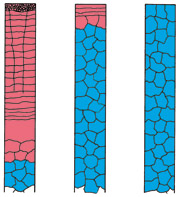
The influence of surface treatment on the
depth of the mechanically affected layer:
ground (l), honed (m), electropolished (r)
Electropolishing is an electrochemical process for material removal from metal surfaces. The part is connected to the positive electrode as an anode, equipped with a cathode and immersed in a material-specific electrolyte. DC voltage is then applied to the part. The effect of the direct current causes metal to be removed from the component surface. The removal takes place without stresses and acts selectively with a preference for areas of microroughness. The surface is made smooth and shiny at the microscopic level. Macroscopic structures remain intact. Removal is more pronounced at edges and corners, which results in reliable fine deburring of the surface to the greatest degree.
Mechanical processing (such as drilling, grinding and polishing) changes or damages materials with the effects of force and heat, which leads to cracks, stresses and changes in the microstructure and reduces the service life of the part. Electropolishing removes these disturbed surface zones, fully restoring the characteristics of the material.
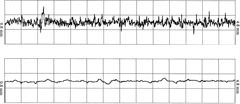
Surface roughness plot for a stainless steel plate:
ground with 180 grit (top), electropolished (bottom)

Electropolished brass key
During the electropolishing of stainless steel, a continuous oxide layer rich in chromium oxide is created on the surface, which forms a passive protection layer against corrosion.
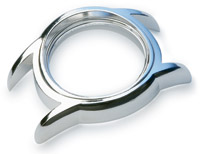
Electropolished stainless steel watch case
Electropolished metal surfaces are used in all branches of industry for a wide variety of applications:

Electropolished stainless steel dynamic hip screw
Electrolytes which can be used industrially for the electropolishing of titanium, titanium alloys, niobium, Nitinol, tantalum and certain cobalt-chromium alloys.
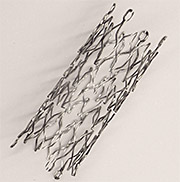
Stent, Nitinol
electropolished
Depending on the surface condition brilliance to high-brilliance surfaces are achieved after an exposure time of about 5 minutes. Higher removal of points and edges causes a leveling of the surface roughness and fine deburring.
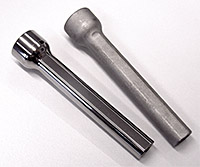
Medical implant, titanium
electropolished (l), untreated (r)
The result is a pure metallic and smoothed surface with maximum corrosion resistance and passivity. The electropolishing process is operated at temperatures between 25° C and 55° C. The possible voltages are preferably between 15 and 30 V.